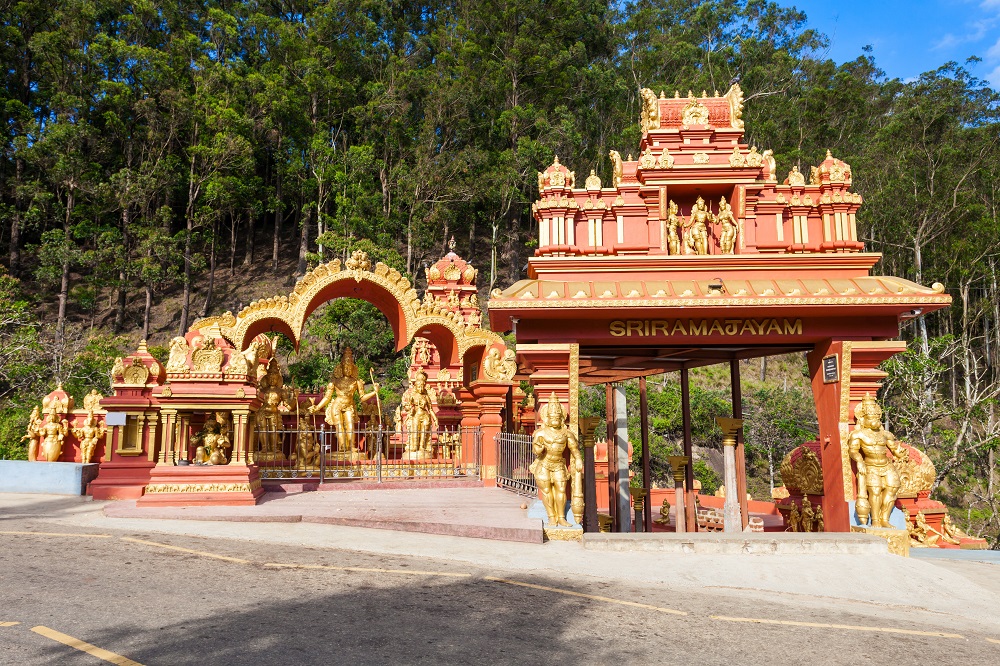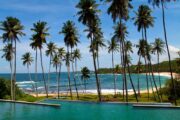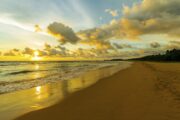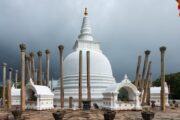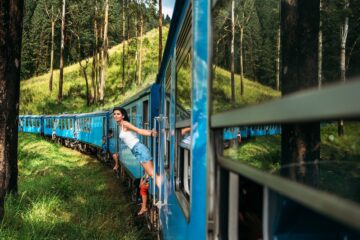For the ones who want to dedicate their vacation to lord Ram, Sita and Hanuman, Yatra has just the right ‘Lankan’ package for you. Visit Kandy-a city located in the centre of Sri Lanka, Nuwara Eliya-a charming hill station developed by the British planters in the late 1800s and Colombo-a bustling metropolis and an attractive blend of old and new.
Day 01: AIPORT – NEGOMBO
Meet on arrival at airport and transfer to Negombo/Waikkal. Dinner and overnight at the hotel.
Day 02: NEGOMBO -CHILAW- KURUNEGALA – KANDY
Breakfast at the hotel. Leave for Munneswaram temple in Chilaw. It is believed that Munneswaram predates the Ramayana.
Lord Rama after his victorious battle left for Ayodhya in one of King Ravana’s Vimanas. He felt he was being followed by a Bramhaasthi dosham as he had killed King Ravana who was a Brahmin. Whilst passing over the area, Rama noticed that the “Brahmaasthi Dosham” was not following him.
He stops the Vimana at this juncture and asks God Shiva for a remedy. God Shiva blessed Lord Rama and advised installing and praying for four lingams, as the only remedy to get rid of the dosham. Munneswaram is open from 5:00 a.m. to 8:00 p.m. (closed from 2 to 5 p.m.).
Proceed to Manaveri. Manavari is the first lingam installed and prayed by Lord Rama and till date this lingam is called as Ramalinga Shivan. Rameshwaram is the only other lingam in the world named after Lord Rama. The Temple is open from 6:00 a.m. to 12:00 noon & from 4:00 p.m. to 7:00 p.m.
Proceed to Kurunegala for lunch. Check in at Kandy hotel. Evening Kandy city sightseeing and shopping tour including a visit to the Sacred Temple of the Tooth relic. Kandy was the last capital of the Sinhala kings and is a world heritage site. Dinner and overnight at a Kandy Hotel.
Day 03: KANDY – PUSSELLAWA -FROTOFT– KANDY
Breakfast at the hotel. Leave to Pussellawa, visit Sita Tear Pond and Chariot R oute atop of Pussellawa Hills. The summit of the hill overlooking Frotoft Estate in Pussallawa is the place where Lord Hanuman first set his foot on Lanka. These hills stand tall in-between King Ravana’s capital city and Ashoka Vatika. The barren land here is believed to be the route in which King Ravana took Sitadevi from his capital city Lankapura to Ashoka Vatika, which was a paradise on earth. Till date no vegetation grows on this passage except grass. King Ravana is believed to have taken this passage on top of these hills to show Sitadevi the beauty of his kingdom.
The Sita tear pond is found en route by the chariot route, is believed to have been formed by the tears of Sitadevi and has not dried up since, even during severe droughts when the adjoining rivers dry up.
In this area there are many large trees whose bright red blooms add colour to the scenery. These flowers are called Sita flowers. The peculiarity of these flowers is the configuration of the petal’s, stamen and pistil’s, which resemble a human figure carrying a bow, and is said to represent Lord Rama. These flowers are unique only to this area in the whole of Sri Lanka.
Proceed to Kurunegala for lunch. Check in at Kandy hotel. Dinner and overnight at a Kandy Hotel.
Day 04: KANDY – HUNNASGIRIYA – HASALAKA – MAHIYANGANAYA
Breakfast at the hotel. Leave Kandy for Mahiyanganaya. Visit Gurulupotha –(area within Capital city of King Ravana)- Weragantota, means ‘a place of aircraft landing’ in Sinhala language, is believed to be the first place where Sitadevi was brought into Lanka in King Ravana’s Vimana. These jungles are the place where the city of Lankapura once stood .The city had a beautiful palace for queen Mandothari surrounded by waterfalls, streams and varieties of flora and fauna. Sitadevi was kept in this palace until she was moved to Ashoka Vatika. The remains that are found are the remnants of later civilizations. This place is now called Sita Kotuwa which means ‘Sita’s Fort’ and got its name because of Sitadevi’s stay here. There was an aircraft repair center in the capital city. This place is known as Gurulupotha. In Valmiki’s depiction King Ravana’s Vimana resembled a huge peacock. The Vimana in Sinhala language means Dhandu Monara which is known as ‘flying peacock’, and hence the name Gurulupotha, which means ‘parts of birds’.
Dinner and overnight at hotel in Mahiyanganaya.
Day 05: MAHIYANGANAYA – BADULLA – WELIMADA – NUWARA ELIYA
Breakfast at the hotel. Leave Mahiyanganaya for Nuwara Eliya
Visit Divurumpola- means a ‘place of oath’. Divurumpola is the place that Sitadevi, after her liberation from King Ravana underwent a test to prove here chastity by offering herself to fire. However she came unscathed and proved here innocence and purity.The message of Rama’s victory over Ravana was sent to Sita. After a bath and adorned with jewels she was taken on a palanquin before Rama.
Meeting her husband after such a long time she was overcome with emotion, but Rama seemed lost in thought. At length he spoke, “I have killed my enemy. I have done my duty as a true king. But you have lived for a year in the enemy’s abode. It is not proper I take you back now.” Sita was shocked. “You have broken my heart” she said, “only the uncultured speak like this”. Have you forgotten the noble family I come from? Is it my fault Ravana carried me off by force? All the time, my mind, my heart, and soul were fixed on you alone, my lord!” She turned to Lakshmana and said with tears streaming from her eyes, “prepare for me a fire. That is the only remedy for this sorrow of mine.” Lakshmana in suppressed anger, looked at Rama’s face, but there was no softening, he lighted a big fire. Sita reverently went round her husband and approached the blazing fire. Joining her palms in salutation, she said, “if I am pure, o fire, protect me.” With these words she jumped into the flames.
Then arose from out of the flames Agni, the fire-god, whom she had invoked. He lifted Sita from the flames unharmed, and presented her to Rama. “Don’t I know that she is spotless and pure at heart?” cried Rama, standing up to receive her. It’s for the sake of the world that I made her go through this ordeal of fire, so that the truth may be known to all.”
The spot was initially fenced and walled to protect it from surrounding wilderness. Then a sapling of the Anuradhapura bodhi tree (one of the 30 original saplings) was planted as a mark of respect of the place. A small dagoba was built subsequently under the Bodhi tree. The temple depicts paintings of the Ramayana epic. Today the temple is revered for the oath taken by Sitadevi and even the legal system permits and accepts the swearing done at this temple while settling disputes between parties.
After lunch visit Seetha Amman temple, Seetha Eliya- The stream that runs from the hill, catered to the needs of Sitadevi during her stay at Ashoka Vatika. She is said to have bathed in this stream. Now there is temple for Lord Rama, Sitadevi, Luxshmana, and Hanuman by the side of this stream. It is interesting to note that foot prints akin to Lord Hanuman’s are found by this river and some are of small size and some are of large size, which tells us of the immense powers of hanuman transforming himself into any size.
Dinner and overnight at hotel in Nuwara Eliya.
Day 06: NUWARA ELIYA – RAMBODA – KANDY
Breakfast at the hotel. Visit Sri Baktha Hanuman Temple, Ramboda. The Ramboda area is believed to be an area where Rama’s forces were gathered against Ravana. RamPadai means Rama’s Force. The hills of Ramboda is also believed where Hanuman was searching for Sitadevi. The Chinmaya mission of Sri Lanka has built an Anjaneyar temple with Hanuman as the presiding deity. This temple is called Sri Baktha Hanuman temple and the image of lord Hanuman here is 16 Feet tall..
The service times at the Sri Baktha Hanuman Temple is between 7:00 am to 12:00 noon and again 3:30 to 6:30 p.m.
Check-in at Nuwara Eliya Hotel and have lunch. After lunch, visit Kondakalai like many other cities and villages in Sri Lanka also derives its name from the Ramayana, when King Ravana took Sitadevi in a chariot to ashoka vatika her hairs got de ranged because of the speed of the chariot. Konda kalai in tamil means deranging of hair. Till date the villagers live with legacy of this event.
Evening visit Mani Kattuther- This is a rock in the Labukalle estate. Lord Hanuman met Sitadevi and on his way to announce this happy information to Lord Rama, rested on this hill top. The hill where Lord Hanuman is believed to have rested after meeting Sitadevi is known as Mani kattuther. Today an open temple with statues of Lord Rama , Sitadevi, Lakshmana and Lord hanuman stands on top of it . Locals visit the temple often.
Dinner and overnight at hotel in Kandy.
Day 07: KANDY – COLOMBO
Breakfast at the hotel. Leave Kandy for Colombo. Visit Kelaniya- Kelaniya is the closest site to Colombo connected to the Ramayana.
After King Ravana’s death, Vibeeshana was coroneted as King of Lanka by Lakshmana at Kelaniya. There are murals enshrined outside the Buddhist temple depicting the crowning of Vibeeshana. The Kelani River is mentioned in the Valmiki Ramayana and Vibeeshana palace was said to be on the banks of this river. The reason Lakshmana crowned Vibeeshana, was because Rama had to return to India as he had to continue his self-exile of 14 years to honour the commitment to his father, King Dasarath of Ajodhya.
Kelaniya is also one of the places visited by Lord Buddha. There exists as Buddhist temple and shrine for King Vibeeshana. Vibeeshana is considered one of the four guardian deities of Sri Lanka, and temples for Vibeeshana are found throughout Sri Lanka. A painting of Kind Vibeeshana adorns the new Parliament of Sri Lanka. In fact there are no temples dedicated for Ravana, but many exist for Vibeeshana; this goes to prove that his stand towards dharma & justice made people to revere him as a god in Sri Lanka. A shrine for Vibeeshana is located at Lankathilake Temple, close to Kandy as well.
King Vibeeshana was considered a fair king, as he supported Rama against his own brother’s injustice. Many devotees that visit king Vibeeshana’s shrine pray to him asking his intervention to a fair recourse to their problems.
After lunch visit Panchamuga Anjaneyar Temple- This is the first Anjaneyar Temple in Sri Lanka. This is also the only Panchamuga (five faced) Anjaneyar Temple in Sri Lanka. This is also the only temple in the world to have a chariot for Ajanyear. The chariot festival is held annually end Dec/ beginning of January.
Hanuman’s mother is Anjan. Hanuman is known as Anjan + Aiyar = Anjaneyar in South India (Hamuman in North India).
The temple is open daily from 5;00 am. Morning Pooja is held at 8;00 am. Noon Pooja at 12:00 noon and closed at 1:00 p.m.
Dinner and overnight at hotel in Colombo.
Day 08: COLOMBO – AIRPORT
After breakfast proceed to airport for departure.
